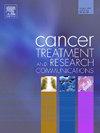Oncological outcomes and locoregional recurrence after fluorescence guided surgery for axillary staging in early breast cancer: A single UK center experience
IF 2.4
Q3 Medicine
引用次数: 0
Abstract
Sentinel lymph node biopsy (SLNB) is an established standard technique for staging the axilla in clinically node-negative breast cancer patients. This study evaluates the efficacy of a dual tracer technique combining Indocyanine Green (ICG) fluorescence and blue dye for SLNB in early breast cancer patients at a single institution (Perth Royal Infirmary, Scotland). Over an eight-month period, 139 patients with clinically node-negative invasive breast cancer underwent SLNB, achieving a sentinel lymph node identification rate of 98.5%. Among the identified nodes, a node positivity rate of 19.7% was observed. With a median follow-up of 42 months, axillary recurrence was recorded in only 0.9% of patients, alongside local and distant recurrences of 1.8% and 5.5%, respectively. The findings suggest that the ICG and blue dye technique maintains a low axillary recurrence rate comparable to traditional methods, while also addressing logistical challenges posed by the COVID-19 pandemic. This technique offers a promising alternative to radioisotope-based methods and opens new possible routes for non-radioactive axillary staging techniques. Further long-term outcomes are anticipated as the use of ICG as a sole tracer is integrated into routine practice.
早期乳腺癌腋窝分期荧光引导手术后的肿瘤预后和局部复发:一个英国中心的经验
前哨淋巴结活检(SLNB)是临床淋巴结阴性乳腺癌患者腋窝分期的标准技术。本研究在单一机构(苏格兰珀斯皇家医院)评估双示踪技术联合吲哚菁绿(ICG)荧光和蓝色染料对早期乳腺癌患者SLNB的疗效。在8个月的时间里,139例临床淋巴结阴性的浸润性乳腺癌患者接受了SLNB,前哨淋巴结的识别率为98.5%。经鉴定的淋巴结中,淋巴结阳性率为19.7%。在42个月的中位随访中,腋窝复发仅占0.9%,局部和远处复发分别为1.8%和5.5%。研究结果表明,ICG和蓝色染料技术与传统方法相比保持了较低的腋下复发率,同时也解决了COVID-19大流行带来的后勤挑战。这项技术为放射性同位素为基础的方法提供了一个有希望的替代方案,并为非放射性腋窝分期技术开辟了新的可能途径。随着ICG作为唯一的示踪剂纳入常规实践,预计进一步的长期结果。
本文章由计算机程序翻译,如有差异,请以英文原文为准。
求助全文
约1分钟内获得全文
求助全文
来源期刊

Cancer treatment and research communications
Medicine-Oncology
CiteScore
4.30
自引率
0.00%
发文量
148
审稿时长
56 days
期刊介绍:
Cancer Treatment and Research Communications is an international peer-reviewed publication dedicated to providing comprehensive basic, translational, and clinical oncology research. The journal is devoted to articles on detection, diagnosis, prevention, policy, and treatment of cancer and provides a global forum for the nurturing and development of future generations of oncology scientists. Cancer Treatment and Research Communications publishes comprehensive reviews and original studies describing various aspects of basic through clinical research of all tumor types. The journal also accepts clinical studies in oncology, with an emphasis on prospective early phase clinical trials. Specific areas of interest include basic, translational, and clinical research and mechanistic approaches; cancer biology; molecular carcinogenesis; genetics and genomics; stem cell and developmental biology; immunology; molecular and cellular oncology; systems biology; drug sensitivity and resistance; gene and antisense therapy; pathology, markers, and prognostic indicators; chemoprevention strategies; multimodality therapy; cancer policy; and integration of various approaches. Our mission is to be the premier source of relevant information through promoting excellence in research and facilitating the timely translation of that science to health care and clinical practice.
 求助内容:
求助内容: 应助结果提醒方式:
应助结果提醒方式:


